The Durability of High-Volume Fly Ash-Based Cement Composites with Synthetic Fibers in a Corrosive Environment: A Long-Term Study
Abstract
:1. Introduction
1.1. Summary of Literature
- The mechanical and durability properties of concretes, cement pastes, and engineered cement composites incorporating F-FA as a partial replacement for OPC have been studied extensively. The utilized water–binder ratio varies between 0.25–0.46 for most of the studies.
- Recent studies focus on the influence of the curing and the use of a hybrid system of fibers on mechanical and durability properties. Researchers have presented different views on using higher-volume fractions of PP fibers.
- There are few long-term durability studies on chloride, sulfate, and the freeze–thaw resistance of concretes incorporating more than 50% F-FA. Most research articles add morphological studies to supplement the experimental findings.
1.2. Scope of the Present Study
2. Materials and Methods
Methods
3. Results
3.1. Free and Combined Chlorides
3.2. Total Chloride Content by Weight of the Binder
3.3. Compressive Strength
3.4. Microstructure of Chloride-Exposed Specimens
4. Discussion
4.1. Total Chloride Content
4.2. Compressive Strength
4.3. Microstructure
5. Conclusions
Author Contributions
Funding
Institutional Review Board Statement
Informed Consent Statement
Data Availability Statement
Acknowledgments
Conflicts of Interest
References
- Pradhan, B. Corrosion Behavior of Steel Reinforcement in Concrete Exposed to Composite Chloride–Sulfate Environment. Constr. Build. Mater. 2014, 72, 398–410. [Google Scholar] [CrossRef]
- Li, C.Q.; Zheng, J.J.; Lawanwisut, W.; Melchers, R.E. Concrete Delamination Caused by Steel Reinforcement Corrosion. J. Mater. Civ. Eng. 2007, 19, 591–600. [Google Scholar] [CrossRef]
- Łowińska-Kluge, A.; Błaszczyński, T. The Influence of Internal Corrosion on the Durability of Concrete. Arch. Civ. Mech. Eng. 2012, 12, 219–227. [Google Scholar] [CrossRef]
- Cabrera, J.G. Deterioration of Concrete Due to Reinforcement Steel Corrosion. Cem. Concr. Compos. 1996, 18, 47–59. [Google Scholar] [CrossRef]
- Thomas, M. Supplementary Cementing Materials in Concrete; CRC Press: Boca Raton, FL, USA, 2013; ISBN 978-0-429-07170-6. [Google Scholar]
- Hsu, S.; Chi, M.; Huang, R. Effect of Fineness and Replacement Ratio of Ground Fly Ash on Properties of Blended Cement Mortar. Constr. Build. Mater. 2018, 176, 250–258. [Google Scholar] [CrossRef]
- Yu, Z.; Ma, J.; Ye, G.; Van Breugel, K.; Shen, X. Effect of Fly Ash on the Pore Structure of Cement Paste under a Curing Period of 3 Years. Constr. Build. Mater. 2017, 144, 493–501. [Google Scholar] [CrossRef]
- Andrade, C.; Buják, R. Effects of Some Mineral Additions to Portland Cement on Reinforcement Corrosion. Cem. Concr. Res. 2013, 53, 59–67. [Google Scholar] [CrossRef]
- Malhotra, V.M.; Mehta, P.K. High-Performance, High-Volume Fly Ash Concrete: Materials, Mixture Proportioning, Properties, Construction Practice, and Case Histories; Supplementary Cementing Materials for Sustainable Development Inc.: Ottawa, ON, Canada, 2002; ISBN 978-0-9731507-0-4. [Google Scholar]
- Papadakis, V.G. Effect of Supplementary Cementing Materials on Concrete Resistance against Carbonation and Chloride Ingress. Cem. Concr. Res. 2000, 30, 291–299. [Google Scholar] [CrossRef]
- de Gutiérrez, R.M.; Díaz, L.N.; Delvasto, S. Effect of Pozzolans on the Performance of Fiber-Reinforced Mortars. Cem. Concr. Compos. 2005, 27, 593–598. [Google Scholar] [CrossRef]
- Reyes-Diaz, E.P.; Martínez-Villafañe, A.; Bastidas, J.M.; TiburcioT, C.G. Corrosion Behavior of Steel Embedded in Ternary Concrete Mixtures. Int. J. Electrochem. Sci. 2011, 6, 1892–1905. [Google Scholar] [CrossRef]
- Zhao, Q.; He, X.; Zhang, J.; Jiang, J. Long-Age Wet Curing Effect on Performance of Carbonation Resistance of Fly Ash Concrete. Constr. Build. Mater. 2016, 127, 577–587. [Google Scholar] [CrossRef] [Green Version]
- Tang, S.W.; Yao, Y.; Andrade, C.; Li, Z.J. Recent Durability Studies on Concrete Structure. Cem. Concr. Res. 2015, 78, 143–154. [Google Scholar] [CrossRef]
- Zhan, P.; Xu, J.; Wang, J.; Jiang, C. Multi-Scale Study on Synergistic Effect of Cement Replacement by Metakaolin and Typical Supplementary Cementitious Materials on Properties of Ultra-High Performance Concrete. Constr. Build. Mater. 2021, 307, 125082. [Google Scholar] [CrossRef]
- Chen, X.-F.; Quan, C.-Q.; Jiao, C.-J. Experimental Study of Chloride Resistance of Polypropylene Fiber Reinforced Concrete with Fly Ash and Modeling. Materials 2021, 14, 4417. [Google Scholar] [CrossRef] [PubMed]
- Fajardo, G.; Valdez, P.; Pacheco, J. Corrosion of Steel Rebar Embedded in Natural Pozzolan Based Mortars Exposed to Chlorides. Constr. Build. Mater. 2009, 23, 768–774. [Google Scholar] [CrossRef]
- Bhanumathidas, N.; Kalidas, N. Sustainable Development through Use of Fly Ash. In Proceedings of the Keynote Paper presented at National Seminar on Building Materials & Technology for Sustainable Development, Ahmedabad, Gujarat, 21–22 January 2005. [Google Scholar]
- Ramezanianpour, A.A. The Role of Supplementary Cementing Materials on Sustainable Development. In Cement Replacement Materials: Properties, Durability, Sustainability; Ramezanianpour, A.A., Ed.; Springer Geochemistry/Mineralogy; Springer: Berlin/Heidelberg, Germany, 2014; pp. 327–336. ISBN 978-3-642-36721-2. [Google Scholar]
- Hashmi, A.F.; Shariq, M.; Baqi, A. Use of HVFA Concrete for Sustainable Development: A Comprehensive Review on Mechanical and Structural Properties. Arab. J. Sci. Eng. 2022, 47, 12265–12288. [Google Scholar] [CrossRef]
- Shi, X.; Xie, N.; Fortune, K.; Gong, J. Durability of Steel Reinforced Concrete in Chloride Environments: An Overview. Constr. Build. Mater. 2012, 30, 125–138. [Google Scholar] [CrossRef]
- Khatib, J.; Jahami, A.; El Kordi, A.; Sonebi, M.; Malek, Z.; Elchamaa, R.; Dakkour, S. Effect of Municipal Solid Waste Incineration Bottom Ash (MSWI-BA) on the Structural Performance of Reinforced Concrete (RC) Beams. J. Eng. Des. Technol. 2021, 21, 862–882. [Google Scholar] [CrossRef]
- Chousidis, N.; Ioannou, I.; Rakanta, E.; Koutsodontis, C.; Batis, G. Effect of Fly Ash Chemical Composition on the Reinforcement Corrosion, Thermal Diffusion and Strength of Blended Cement Concretes. Constr. Build. Mater. 2016, 126, 86–97. [Google Scholar] [CrossRef]
- Chousidis, N.; Rakanta, E.; Ioannou, I.; Batis, G. Mechanical Properties and Durability Performance of Reinforced Concrete Containing Fly Ash. Constr. Build. Mater. 2015, 101, 810–817. [Google Scholar] [CrossRef]
- Bilodeau, A.; Malhotra, V.M. High-Volume Fly Ash System: Concrete Solution for Sustainable Development. Mater. J. 2000, 97, 41–48. [Google Scholar] [CrossRef]
- Qu, F.; Li, W.; Dong, W.; Tam, V.W.Y.; Yu, T. Durability Deterioration of Concrete under Marine Environment from Material to Structure: A Critical Review. J. Build. Eng. 2021, 35, 102074. [Google Scholar] [CrossRef]
- Phiêu, L.T.; Lành, H.S.; Thanh, H.T.T.; Dung, H.T.M.; Chánh, Đ.C.; Phước, H.T. The Influence of High-Volume Fly Ash Content on Mechanical Properties of Cement Paste. Tạp Chí Khoa Học Và Công Nghệ Đại Học Đà Nẵng 2022, 20, 121–125. [Google Scholar]
- Ho, L.S.; Huynh, T.-P. Long-Term Mechanical Properties and Durability of High-Strength Concrete Containing High-Volume Local Fly Ash as a Partial Cement Substitution. Results Eng. 2023, 18, 101113. [Google Scholar] [CrossRef]
- Herath, C.; Gunasekara, C.; Law, D.W.; Setunge, S. Performance of High Volume Fly Ash Concrete Incorporating Additives: A Systematic Literature Review. Constr. Build. Mater. 2020, 258, 120606. [Google Scholar] [CrossRef]
- Kumar, M.; Sinha, A.K.; Kujur, J. Mechanical and Durability Studies on High-Volume Fly-Ash Concrete. Struct. Concr. 2021, 22, E1036–E1049. [Google Scholar] [CrossRef]
- Aydin, E.; Arel, H.Ş. Characterization of High-Volume Fly-Ash Cement Pastes for Sustainable Construction Applications. Constr. Build. Mater. 2017, 157, 96–107. [Google Scholar] [CrossRef]
- Moon, G.D.; Oh, S.; Choi, Y.C. Effects of the Physicochemical Properties of Fly Ash on the Compressive Strength of High-Volume Fly Ash Mortar. Constr. Build. Mater. 2016, 124, 1072–1080. [Google Scholar] [CrossRef]
- Babalu, R.; Anil, A.; Sudarshan, K.; Amol, P. Compressive Strength, Flexural Strength, and Durability of High-Volume Fly Ash Concrete. Innov. Infrastruct. Solut. 2023, 8, 154. [Google Scholar] [CrossRef]
- Li, J.; Wu, Z.; Shi, C.; Yuan, Q.; Zhang, Z. Durability of Ultra-High Performance Concrete—A Review. Constr. Build. Mater. 2020, 255, 119296. [Google Scholar] [CrossRef]
- Yu, Y.; Yu, J.; Ge, Y. Water and Chloride Permeability Research on Ordinary Cement Mortar and Concrete with Compound Admixture and Fly Ash. Constr. Build. Mater. 2016, 127, 556–564. [Google Scholar] [CrossRef]
- Concrete Durability Presented by Acceptable Chloride Level and Chloride Diffusion Coefficient in Concrete: 10-Year Results in Marine Site|SpringerLink. Available online: https://link.springer.com/article/10.1617/s11527-013-0131-4 (accessed on 14 June 2023).
- Lollini, F.; Redaelli, E.; Bertolini, L. Investigation on the Effect of Supplementary Cementitious Materials on the Critical Chloride Threshold of Steel in Concrete. Mater. Struct. 2016, 49, 4147–4165. [Google Scholar] [CrossRef] [Green Version]
- Filho, J.H.; Medeiros, M.H.F.; Pereira, E.; Helene, P.; Isaia, G.C. High-Volume Fly Ash Concrete with and without Hydrated Lime: Chloride Diffusion Coefficient from Accelerated Test. J. Mater. Civ. Eng. 2013, 25, 411–418. [Google Scholar] [CrossRef] [Green Version]
- Shaikh, F.U.A.; Supit, S.W.M. Chloride Induced Corrosion Durability of High Volume Fly Ash Concretes Containing Nano Particles. Constr. Build. Mater. 2015, 99, 208–225. [Google Scholar] [CrossRef]
- Moffatt, E.G.; Thomas, M.D.A.; Fahim, A. Performance of High-Volume Fly Ash Concrete in Marine Environment. Cem. Concr. Res. 2017, 102, 127–135. [Google Scholar] [CrossRef]
- Ma, H.; Yi, C.; Wu, C. Review and Outlook on Durability of Engineered Cementitious Composite (ECC). Constr. Build. Mater. 2021, 287, 122719. [Google Scholar] [CrossRef]
- Liu, J.; Wang, Y. Predicting the Chloride Diffusion in Concrete Incorporating Fly Ash by a Multi-Scale Model. J. Clean. Prod. 2022, 330, 129767. [Google Scholar] [CrossRef]
- Turk, K.; Kina, C.; Nehdi, M.L. Durability of Engineered Cementitious Composites Incorporating High-Volume Fly Ash and Limestone Powder. Sustainability 2022, 14, 10388. [Google Scholar] [CrossRef]
- Rashad, A.M.; Ouda, A.S. Effect of Tidal Zone and Seawater Attack on High-Volume Fly Ash Pastes Enhanced with Metakaolin and Quartz Powder in the Marine Environment. Microporous Mesoporous Mater. 2021, 324, 111261. [Google Scholar] [CrossRef]
- Yu, J.; Zhang, M.; Li, G.; Meng, J.; Leung, C.K.Y. Using Nano-Silica to Improve Mechanical and Fracture Properties of Fiber-Reinforced High-Volume Fly Ash Cement Mortar. Constr. Build. Mater. 2020, 239, 117853. [Google Scholar] [CrossRef]
- Wang, J.; Dong, H. PVA Fiber-Reinforced Ultrafine Fly Ash Concrete: Engineering Properties, Resistance to Chloride Ion Penetration, and Microstructure. J. Build. Eng. 2023, 66, 105858. [Google Scholar] [CrossRef]
- Liu, Y.; Wang, L.; Cao, K.; Sun, L. Review on the Durability of Polypropylene Fibre-Reinforced Concrete. Adv. Civ. Eng. 2021, 2021, e6652077. [Google Scholar] [CrossRef]
- Ammasi, A.K. Ragul Strength and Durability of High Volume Fly Ash in Engineered Cementitious Composites. Mater. Today Proc. 2018, 5, 24050–24058. [Google Scholar] [CrossRef]
- Afroz, M.; Venkatesan, S.; Patnaikuni, I. Effects of Hybrid Fibers on the Development of High Volume Fly Ash Cement Composite. Constr. Build. Mater. 2019, 215, 984–997. [Google Scholar] [CrossRef]
- IS 4031-1; Methods of Physical Tests for Hydraulic Cement, Part 1: Determination of Fineness by Dry Sieving. Bureau of Indian Standards: Chandigarh, India, 1996.
- IS 4031-11; Methods of Physical Tests for Hydraulic Cement, Part 11: Determination of Density. Bureau of Indian Standards: Chandigarh, India, 1988.
- IS 4031-4; Methods of Physical Tests for Hydraulic Cement, Part 4: Determination of Consistency of Standard Cement Paste. Bureau of Indian Standards: Chandigarh, India, 1988.
- IS 4031-5; Methods of Physical Tests for Hydraulic Cement, Part 5: Determination of Initial and Final Setting Times. Bureau of Indian Standards: Chandigarh, India, 1988.
- IS 4031-6; Methods of Physical Tests for Hydraulic Cement, Part 6: Determination of Compressive Strength of Hydraulic Cement (Other than Masonry Cement). Bureau of Indian Standards: Chandigarh, India, 1988.
- IS 1727; Methods of Test for Pozzolanic Materials. Bureau of Indian Standards: Chandigarh, India, 1967.
- IS 3812-1; Specification for Pulverized Fuel Ash, Part 1: For Use as Pozzolana in Cement, Cement Mortar and Concrete. Bureau of Indian Standards: Chandigarh, India, 2003.
- NORDTEST; Author Concrete, Hardened: Accelerated Chloride Penetration (NT BUILD 443). Bureau of Indian Standards: Chandigarh, India, 1995.
- NT Build 208. Concrete, Hardened: Chloride Content by Volhard Titration; Nordtest: Esbo, Finland, 1996. [Google Scholar]
- IS 516; Method of Tests for Strength of Concrete. Bureau of Indian Standards: Chandigarh, India, 1959.
- Chalhoub, C.; François, R.; Carcasses, M. Critical Chloride Threshold Values as a Function of Cement Type and Steel Surface Condition. Cem. Concr. Res. 2020, 134, 106086. [Google Scholar] [CrossRef]
- EN 206-1:2000/A1:2004; Concrete-Part 1: Specification, Performance, Production and Conformity. British Standards Institution: London, UK, 2000.
- Liu, J.; Jiang, Z.; Zhao, Y.; Zhou, H.; Wang, X.; Zhou, H.; Xing, F.; Li, S.; Zhu, J.; Liu, W. Chloride Distribution and Steel Corrosion in a Concrete Bridge after Long-Term Exposure to Natural Marine Environment. Materials 2020, 13, 3900. [Google Scholar] [CrossRef]
- Khan, M.U.; Ahmad, S.; Al-Gahtani, H.J. Chloride-Induced Corrosion of Steel in Concrete: An Overview on Chloride Diffusion and Prediction of Corrosion Initiation Time. Int. J. Corros. 2017, 2017, e5819202. [Google Scholar] [CrossRef] [Green Version]
- Falaciński, P.; Machowska, A.; Szarek, Ł. The Impact of Chloride and Sulphate Aggressiveness on the Microstructure and Phase Composition of Fly Ash-Slag Mortar. Materials 2021, 14, 4430. [Google Scholar] [CrossRef]
- Du, S.; Zhao, Q.; Shi, X. High-Volume Fly Ash-Based Cementitious Composites as Sustainable Materials: An Overview of Recent Advances. Adv. Civ. Eng. 2021, 2021, e4976169. [Google Scholar] [CrossRef]
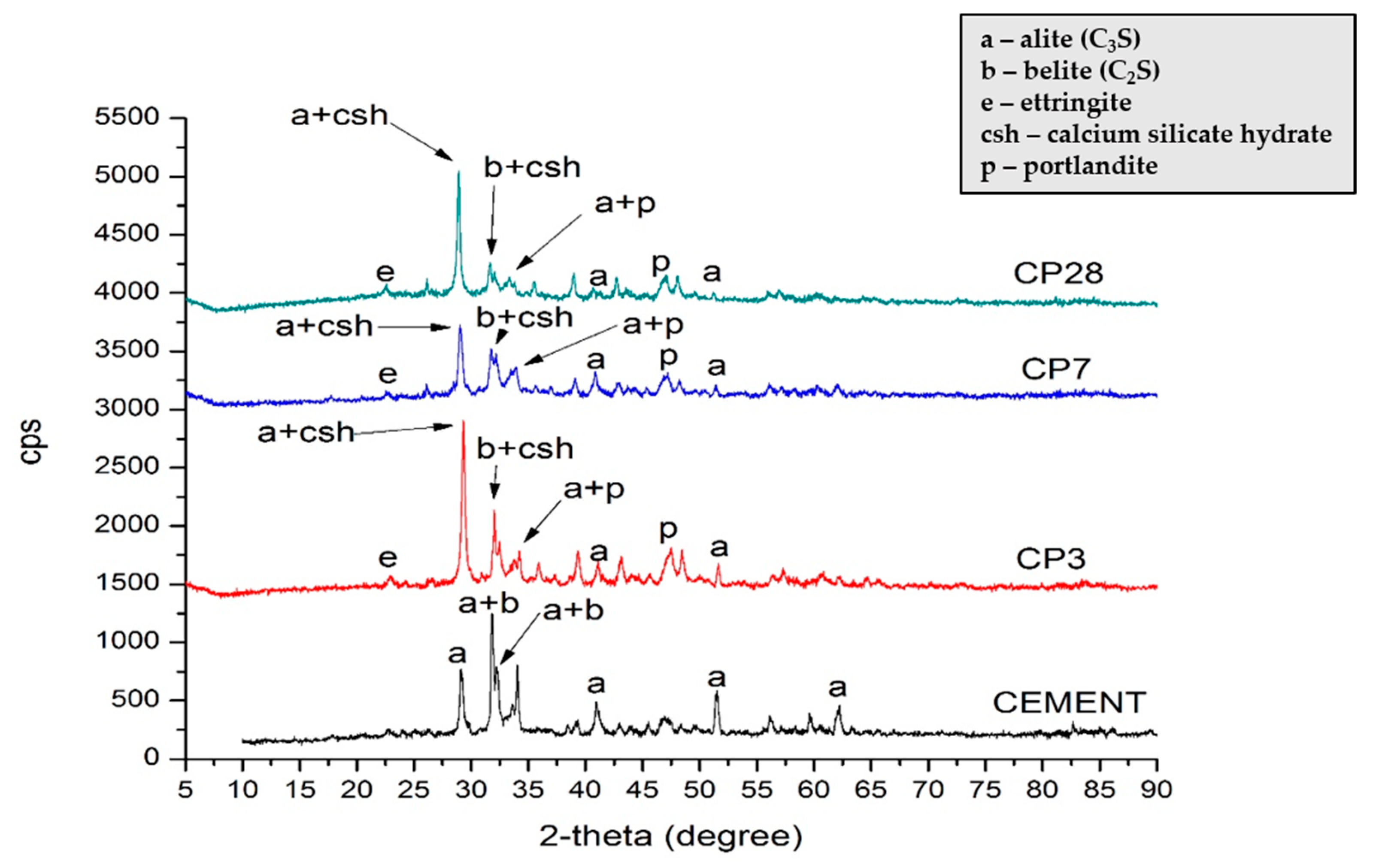

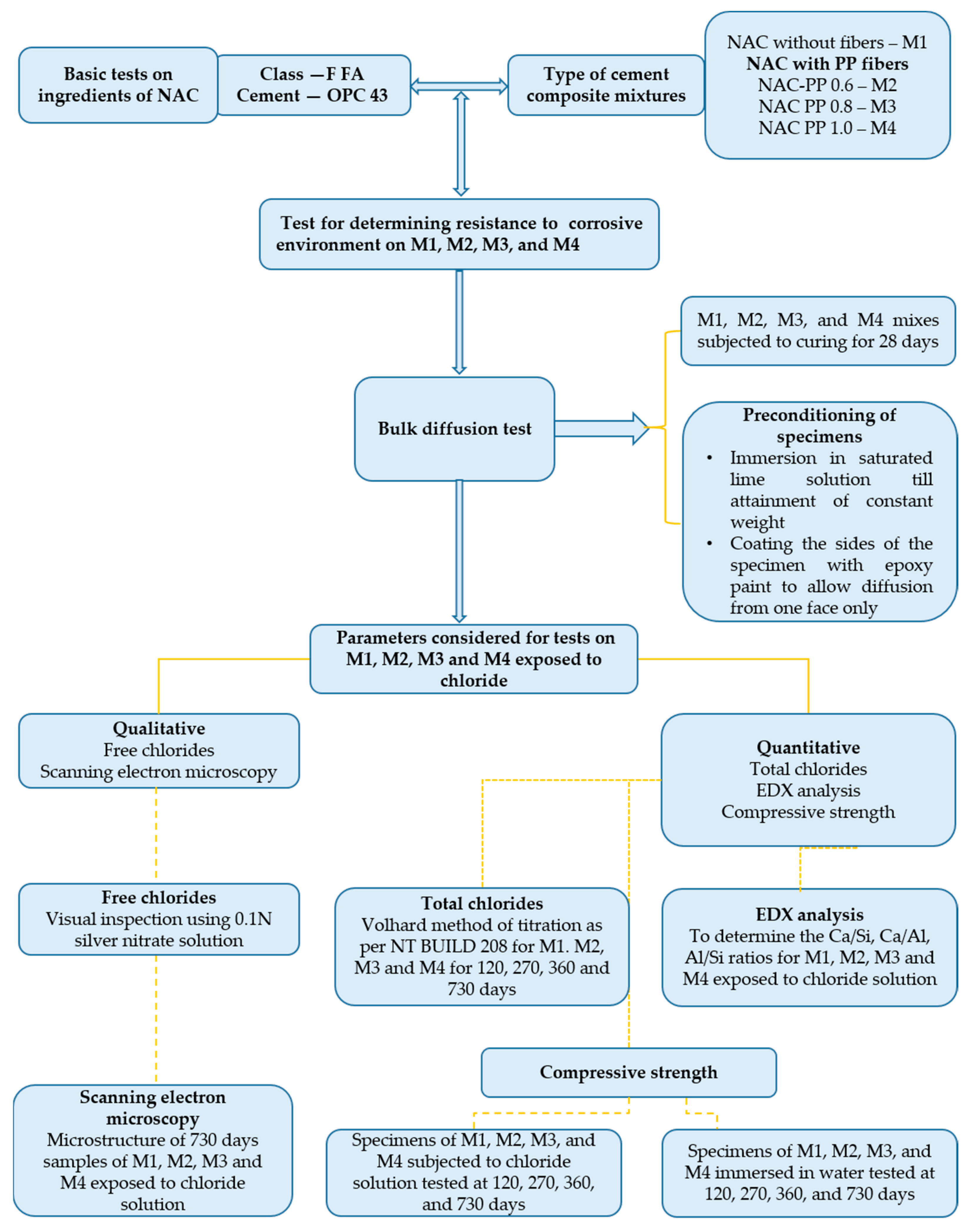



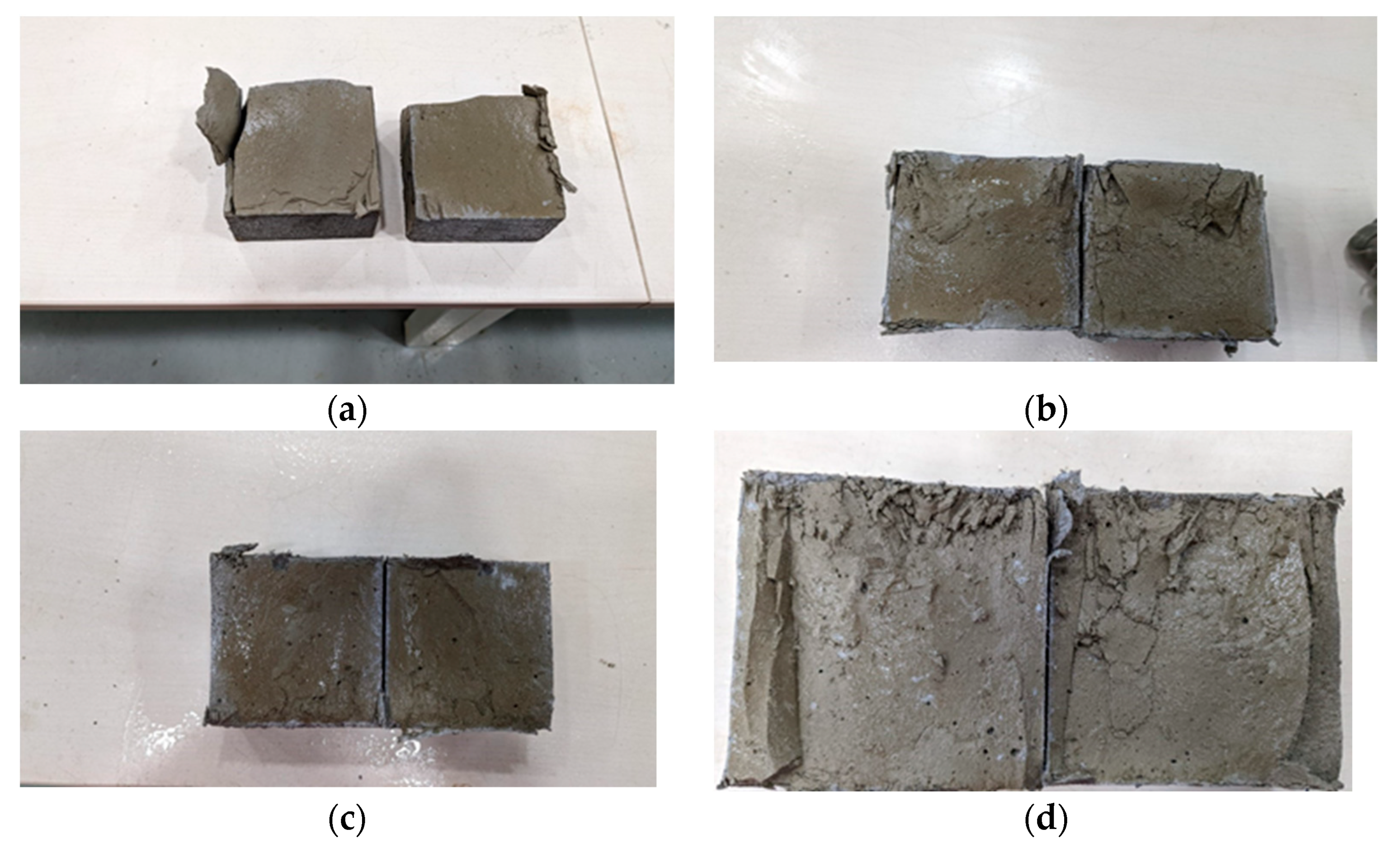
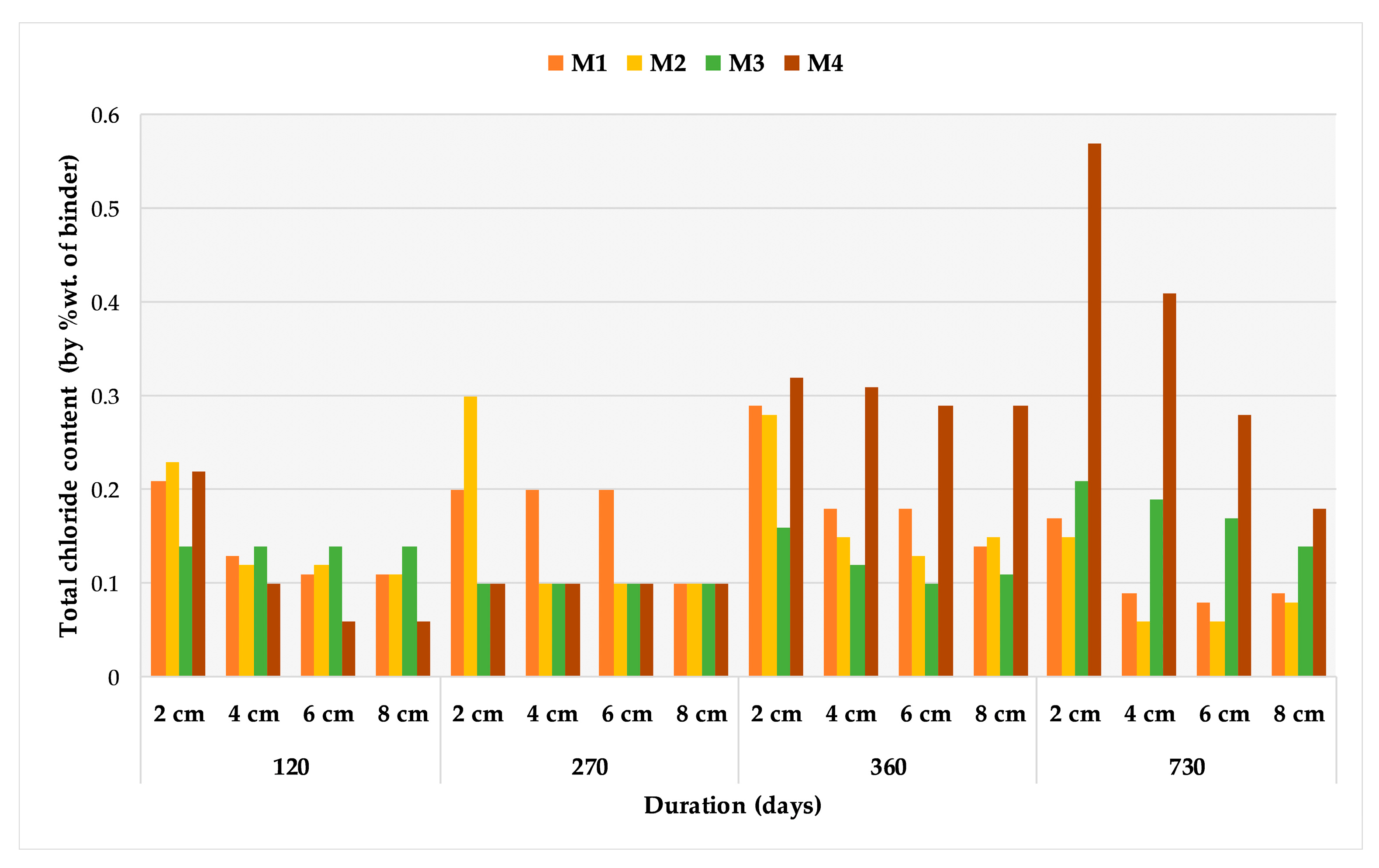
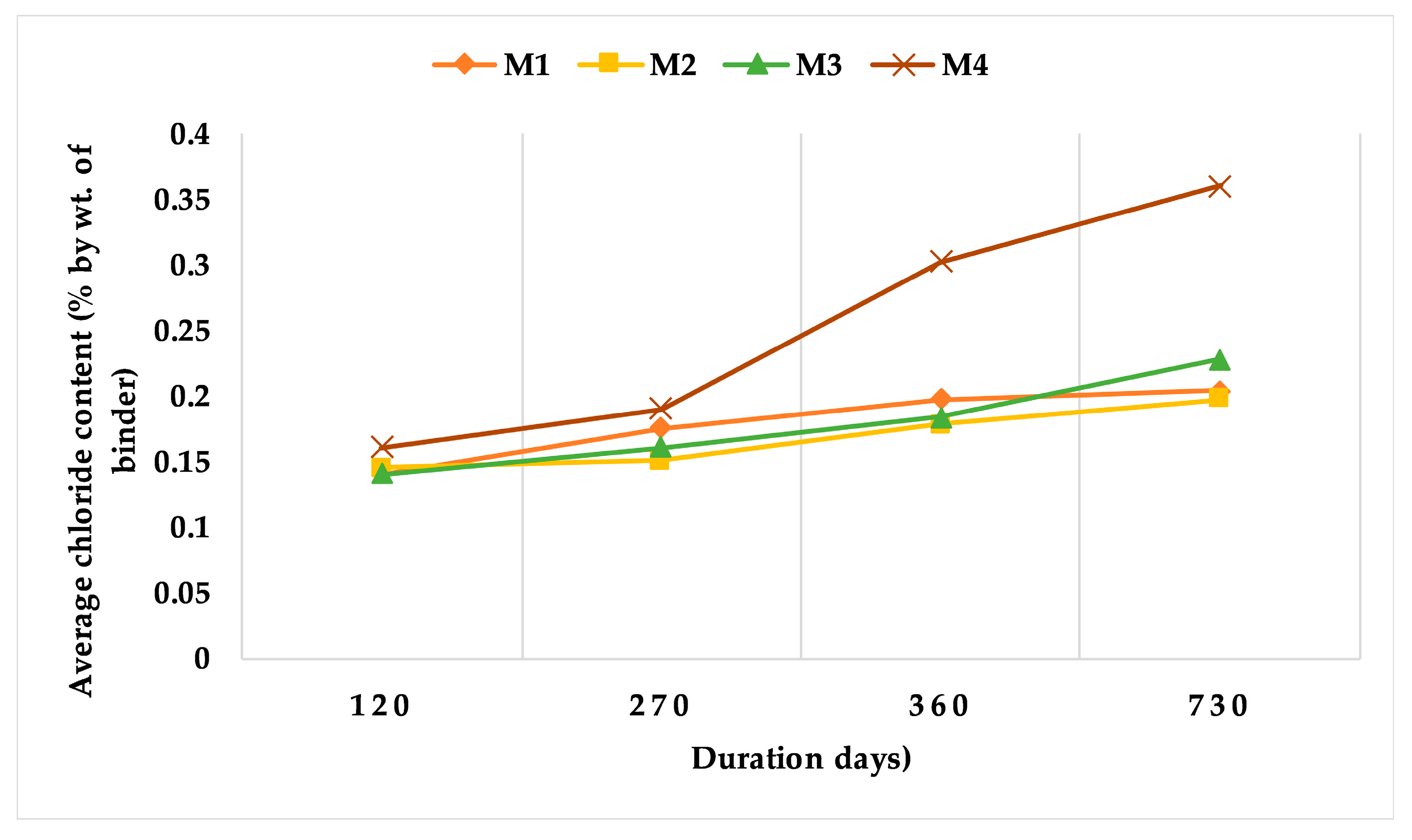
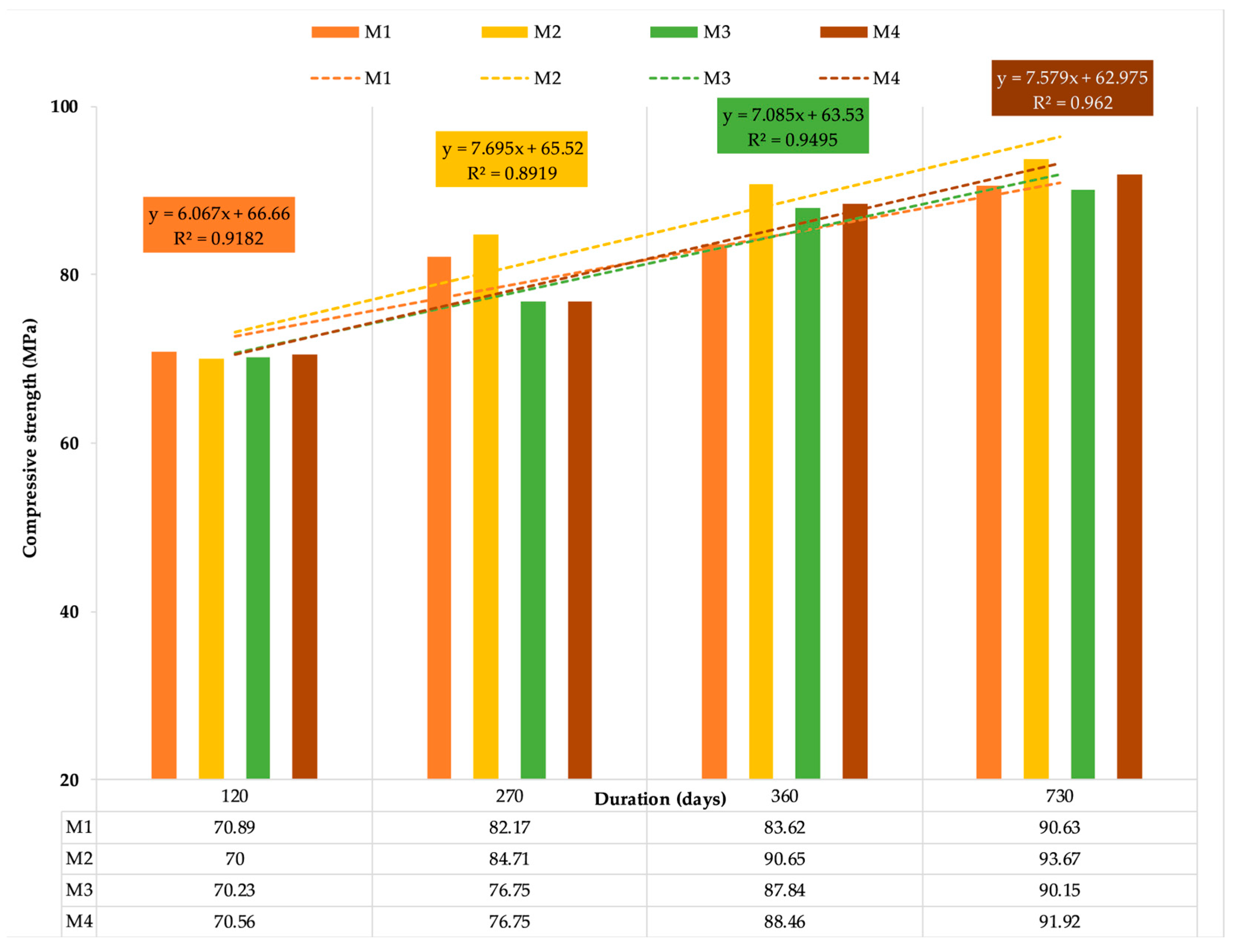
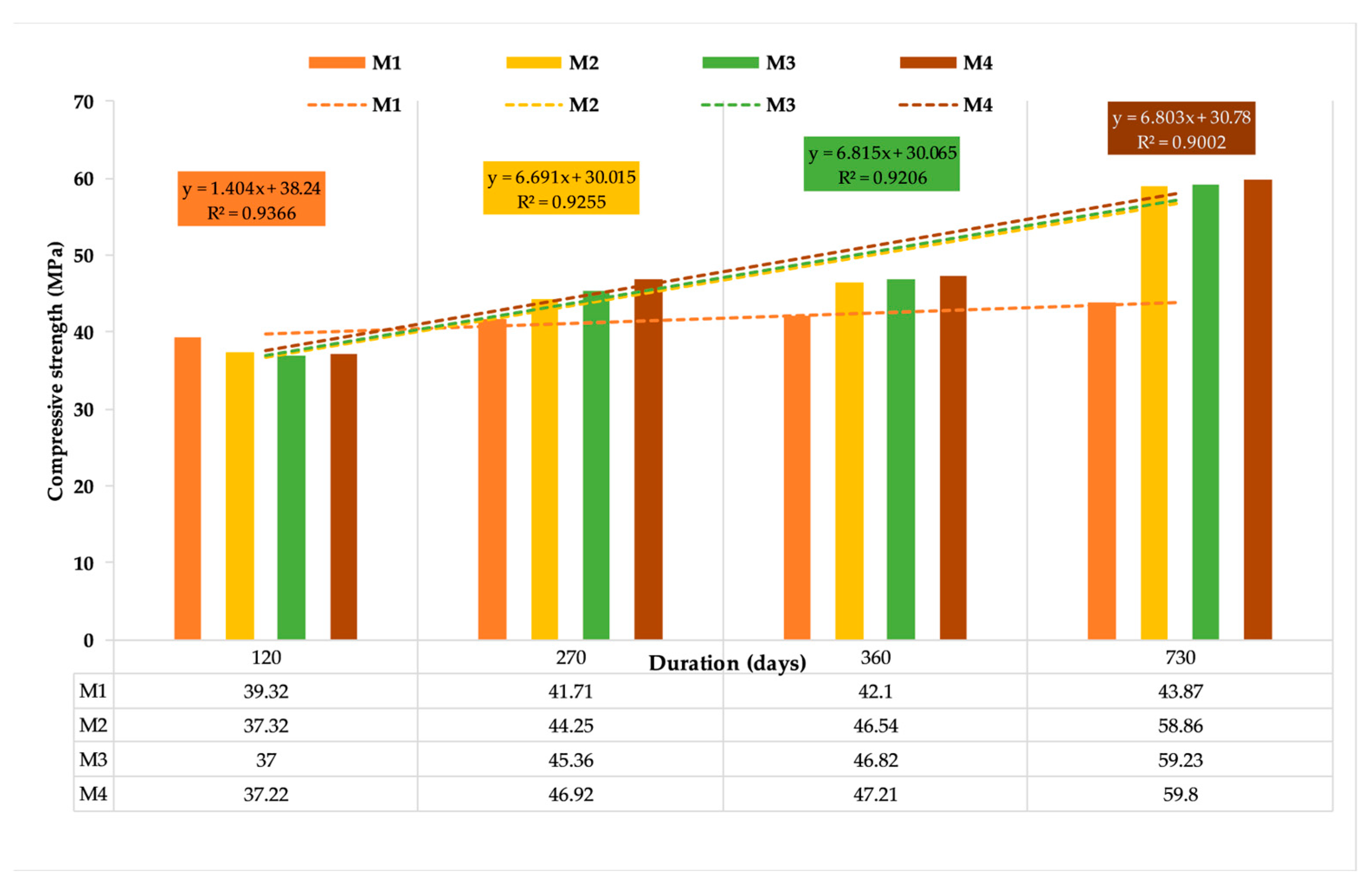
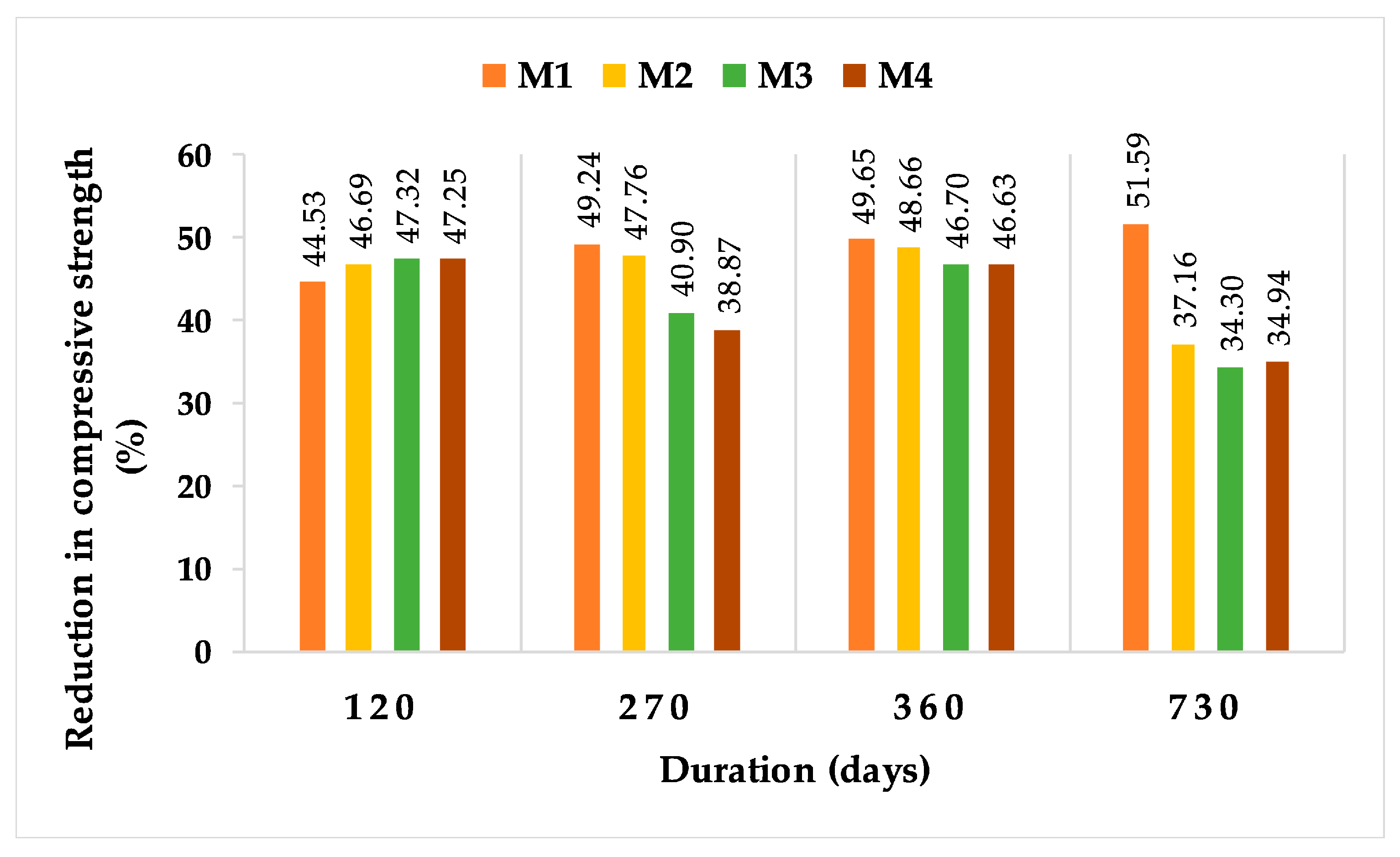
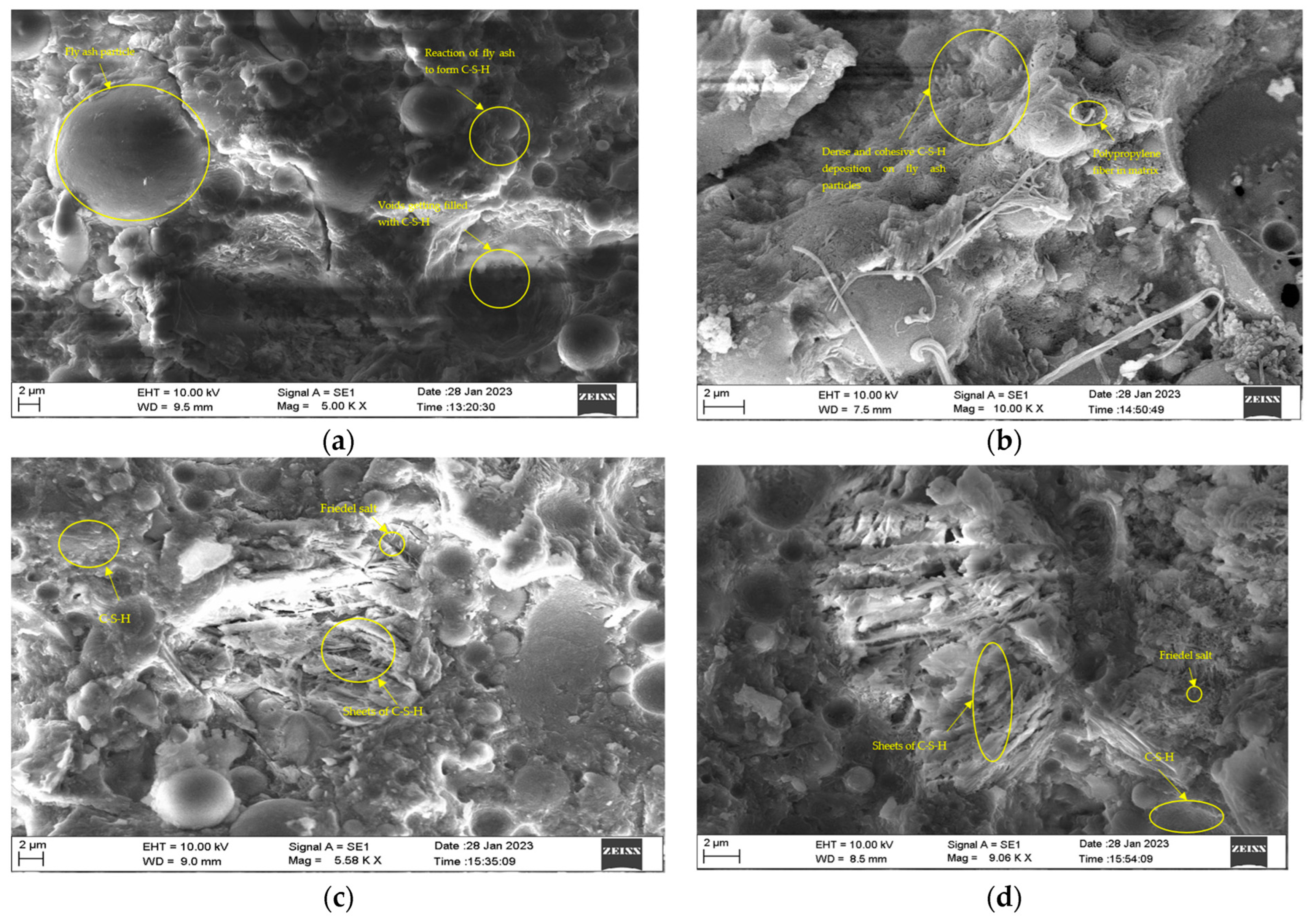

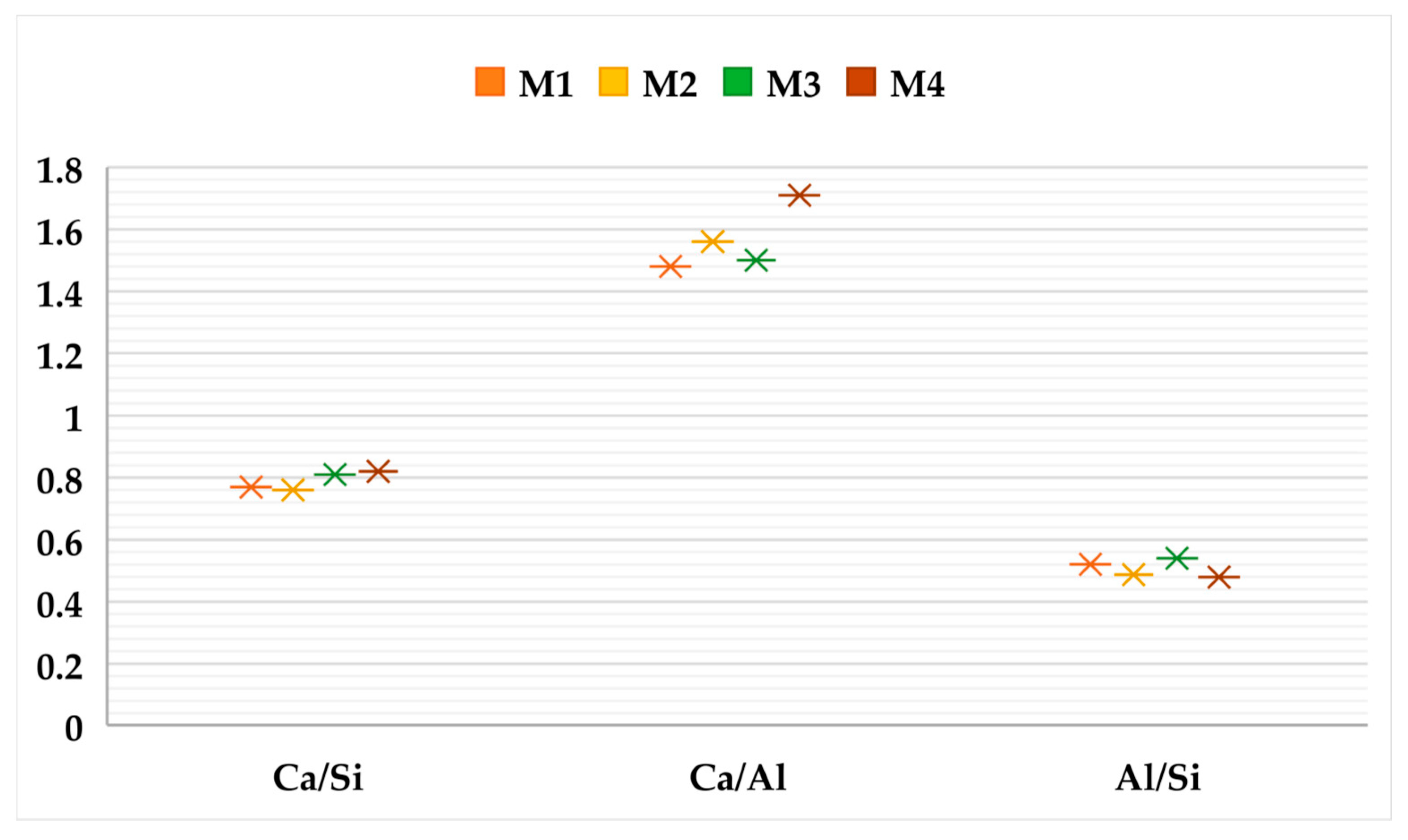
| Chemical Composition | Percentage |
|---|---|
| SiO2 | 61.18 |
| MgO | 1.77 |
| SO3 | 0.31 |
| Chlorides | 0.005 |
| Na2O | 0.28 |
| CaO | 3.08 |
| K2O | 0.94 |
| Al2O3 | 24.98 |
| Fe2O3 | 4.47 |
| Loss on ignition | 0.20 |
| Materials | Tests | IS Code | Results | Requirement | Conformity | |
|---|---|---|---|---|---|---|
| Cement: OPC 43 grade | Fineness (90 µ) | IS 4031 (part I) 1988/R2019 [50] | 7.3% | <10% | Yes | |
| Specific gravity | IS 4031 (part 11) 1988/R2019 [51] | 3.13 | - | - | ||
| Consistency | IS 4031—(part 4)—1988 [52] | 30% | - | - | ||
| Initial setting time | IS 4031 (part 5) 1988/R2019 [53] | 190 min | 30 min (minimum) | Yes | ||
| Final setting time | IS 4031 (part 5) 1988/R2019 [53] | 270 min | 600 min (maximum) | Yes | ||
| Compressive strength test on mortar | IS 4031 (part 6) 1988/R2019 [54] | 3 days | 29.09 Mpa | 23 MPa | Yes | |
| 7 days | 35.11 Mpa | 33 MPa | Yes | |||
| 28 days | 44.14 MPa | 43 MPa | Yes | |||
| Fly ash (Class-F) | Fineness by wet sieve analysis | IS 1727-1967 [55] | 12% | 34% as per IS 3812 [56] | yes | |
| Specific Gravity | IS 1727-1967 [55] | 2.10 | - | - | ||
| Consistency | IS 1727-1967 [55] (IS 4031-1988-part IV) | 31% | - | - | ||
| Initial and final setting | IS 1727-1967 [55] (IS 4031-1988-part V) | 285 min. and 320 min | - | - | ||
| Compressive strength test for CM, 50 mm Cubes | IS 1727-1967 [55] | 47.03 MPa | - | |||
| Compressive strength test for 80(OPC):20(F-FA), 50 mm cubes | IS 1727-1967 [55] | 49.6 MPa | - | - | ||
| PAI @ 28 days of curing | IS 1727-1967 [55] | 1.054 | - | - | ||
| Mix. No. | Name | Cement | Fly Ash | Water | Admixture | PP Fibers |
|---|---|---|---|---|---|---|
| M1 | NAC | 325 | 1300 | 243.75 | 6.5 | 0 |
| M2 | NAC PP 0.6 | 325 | 1300 | 243.75 | 6.5 | 5.52 |
| M3 | NAC PP 0.8 | 325 | 1300 | 243.75 | 6.5 | 7.36 |
| M4 | NAC PP 1.0 | 325 | 1300 | 243.75 | 6.5 | 9.2 |
Disclaimer/Publisher’s Note: The statements, opinions and data contained in all publications are solely those of the individual author(s) and contributor(s) and not of MDPI and/or the editor(s). MDPI and/or the editor(s) disclaim responsibility for any injury to people or property resulting from any ideas, methods, instructions or products referred to in the content. |
© 2023 by the authors. Licensee MDPI, Basel, Switzerland. This article is an open access article distributed under the terms and conditions of the Creative Commons Attribution (CC BY) license (https://creativecommons.org/licenses/by/4.0/).
Share and Cite
Sugandhini, H.K.; Nayak, G.; Shetty, K.K.; Kudva, L.P. The Durability of High-Volume Fly Ash-Based Cement Composites with Synthetic Fibers in a Corrosive Environment: A Long-Term Study. Sustainability 2023, 15, 11481. https://doi.org/10.3390/su151511481
Sugandhini HK, Nayak G, Shetty KK, Kudva LP. The Durability of High-Volume Fly Ash-Based Cement Composites with Synthetic Fibers in a Corrosive Environment: A Long-Term Study. Sustainability. 2023; 15(15):11481. https://doi.org/10.3390/su151511481
Chicago/Turabian StyleSugandhini, H. K., Gopinatha Nayak, Kiran K. Shetty, and Laxman P. Kudva. 2023. "The Durability of High-Volume Fly Ash-Based Cement Composites with Synthetic Fibers in a Corrosive Environment: A Long-Term Study" Sustainability 15, no. 15: 11481. https://doi.org/10.3390/su151511481






